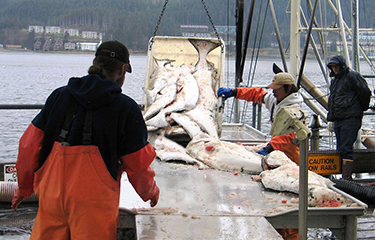Optimistic outlook for Pacific halibut market ahead of season opener

The Pacific halibut fishery opens on Saturday, 6 March, and increased catch limits, combined with a cautiously optimistic outlook for the near future, have fanned interest in buying shares of the popular fish.
In January, the International Pacific Halibut Commission boosted total halibut removals for 2021 by 6.5 percent to 39 million pounds for all users and as bycatch in fisheries of the U.S. West Coast, British Columbia, and Alaska. That is higher than the total take for the past three years.
For commercial fishermen, the halibut catch limit of 25.7 million pounds is an increase of 2.6 million pounds over 2020. Alaska gets the largest chunk at 19.6 million pounds, and all regions except for the Bering Sea will see increased catches.
“People are thrilled to see that, hopefully, the tide has turned after catch limits for most areas have been declining for about the past 15 years. And they are happy to know they're going to see some more pounds on their permits this year,” Homer, Alaska-based Alaska Boats and Permits owner Doug Bowen said.
Permit Master broker Lisa Gulliford in Tacoma, Washington agreed.
“By all accounts, the market looks like it is warming up,” Gulliford said. “Interest and flexibility from both buyers and sellers is always good news, and I am hopeful this trend will continue through the year.”
Optimism over the apparent better health of the halibut stock is reflected in the demand for purchasing shares of the fish that is pushing up prices, Bowen said.
It’s nowhere near the levels from 2017, when quota share prices in the Central Gulf of Alaska, for example, were at USD 65 (EUR 54) or more per pound. Now they’re closer to USD 45 (EUR 37). Quota shares at Southeast that topped USD 70 (EUR 58) are listed in the USD 45 (EUR 37) to high USD 50 (EUR 41) range per pound.
The increase in halibut catches is one part of the equation – the other is what the fish will bring at the docks.
“We were seeing some decline in values even before the pandemic hit, with increased imports from the east coast of Canada and halibut coming in from Russia and even farmed halibut showing up in Costco from Norway. So there's more competition in the marketplace. And then the pandemic didn't help with all the restaurants closed and the cruise ships tied up," Bowen said. "Even with all that, we still saw pretty decent prices last year. In Homer, we probably averaged [USD 4.50, EUR 3.75] a pound for the whole season. Considering the pandemic and the hit to the economy, that was probably a pretty good price. And we're hoping to see a good price again this year.”
Federal data show the annual average ex-vessel (dock) price for halibut has been decreasing since 2016. The price to Alaska fishermen in 2020 averaged USD 4.00 (EUR 3.34) per pound and the value of the fishery totaled just under USD 62 million (EUR 51 million). That’s compared to an average dock price of USD 5.30 (EUR 4.42) per pound in 2019 and a fishery value of more than USD 87 million (EUR 72 million).
Bowen said another good sign is that boat sales are “brisk.”
“I don't know whether you could find a stronger vote of confidence in investing into these fisheries by buying a boat or buying quota,” he said. “So yeah, there's definitely some optimism in the fishery in spite of this pandemic that's going on in the background. It's very encouraging.”
The Pacific halibut fishery this year also was extended by one month to 7 December.
Commission launches survey of halibut stakeholders
The International Pacific Halibut Commission (IPHC) is conducting a major study of how Pacific halibut is being used, with a stakeholder survey aiming for an assessment of the economic impact of the halibut resource in Canada and the U.S.
The survey seeks information from halibut users in commercial, sport charter, subsistence, and processor sectors. It measures economic impacts from hook to plate, employment and incomes, household prosperity, and contributions to regional and national economies – known more broadly as multiplier effects.
“So per dollar of landed fish, how much economic activity is generated and how much of this translates to wages and to the national GDP. That encompasses effects on wages, but also effects on profits by the businesses that are supported by the commercial or recreational fisheries,” Barbara Hutniczak, IPHC lead economist for the study, said.
The survey also looks at regional spillovers to other areas.
“For example, a vessel that is fishing in Alaska and benefiting from the Alaska-based halibut resource might in the winter time be serviced in Washington state. So in this case, the economic effects will also be in Washington state because the marina where this vessel is serviced will have additional economic activities,” Hutniczak said.
The confidential survey includes four main sections on vessel activities, revenue, quota use, labor information, and vessel operating expenses. Hutniczak said responses are accepted on a rolling basis and the information will be updated continuously.
Reporting by Laine Welch
Photo courtesy of NOAA






Share